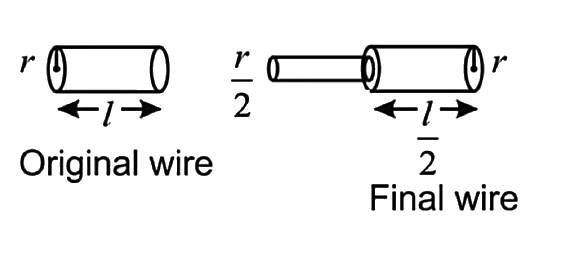A wire of lenth L is drawn such that its diameter is reduced to half of its original diamter. If the initial resistance of the wire were 10Ω, its new resistance would be
40Ω
80Ω
120Ω
160Ω
The correct Answer is:D
To solve the problem, we need to determine the new resistance of a wire after it has been drawn such that its diameter is reduced to half of its original diameter. We know the initial resistance of the wire is 10Ω.
1. Understand the relationship between resistance, length, and area:
The resistance R of a wire is given by the formula:
R=ρLA
where:
- R is the resistance,
- ρ is the resistivity of the material,
- L is the length of the wire,
- A is the cross-sectional area of the wire.
2. Calculate the initial area:
The cross-sectional area A of a wire with diameter d is given by:
A=π(d2)2=πd24
Let the original diameter be d. Therefore, the initial area A is:
A=πd24
3. Determine the new dimensions after drawing the wire:
When the diameter is reduced to half, the new diameter d′=d2. The new radius r′=d′2=d4.
4. Calculate the new area:
The new cross-sectional area A′ becomes:
A′=π(d′2)2=π(d/22)2=π(d4)2=πd216
5. Use the volume conservation principle:
The volume of the wire remains constant before and after drawing. Thus:
A⋅L=A′⋅L′
Substituting the areas we found:
πd24⋅L=πd216⋅L′
Simplifying this gives:
L′=4L
6. Calculate the new resistance:
The new resistance R′ can be calculated using the resistance formula:
R′=ρL′A′
Substituting L′=4L and A′=πd216:
R′=ρ(4L)πd216=64ρLπd2
Since R=ρLA=10Ω, we can relate R′ to R:
R′=16R
Therefore:
R′=16×10Ω=160Ω
Final Answer:
The new resistance of the wire is 160Ω.
The resistance R of a wire is given by the formula:
R=ρLA
where:
- R is the resistance,
- ρ is the resistivity of the material,
- L is the length of the wire,
- A is the cross-sectional area of the wire.
The cross-sectional area A of a wire with diameter d is given by:
A=π(d2)2=πd24
Let the original diameter be d. Therefore, the initial area A is:
A=πd24
When the diameter is reduced to half, the new diameter d′=d2. The new radius r′=d′2=d4.
The new cross-sectional area A′ becomes:
A′=π(d′2)2=π(d/22)2=π(d4)2=πd216
The volume of the wire remains constant before and after drawing. Thus:
A⋅L=A′⋅L′
Substituting the areas we found:
πd24⋅L=πd216⋅L′
Simplifying this gives:
L′=4L
The new resistance R′ can be calculated using the resistance formula:
R′=ρL′A′
Substituting L′=4L and A′=πd216:
R′=ρ(4L)πd216=64ρLπd2
Since R=ρLA=10Ω, we can relate R′ to R:
R′=16R
Therefore:
R′=16×10Ω=160Ω
The new resistance of the wire is 160Ω.
Similar Questions
A wire of length l has a resistance R. If half of the length is stretched to make the radius half of its original value, then the final resistance of the wire is

View SolutionIf a wire of resistance R is melted and recasted in to half of its length, then the new resistance of the wire will be
View SolutionIf a wire is stretched to four times its length, then the specific resistance of the wire will
View SolutionA resistance 10Ω is stretched to twice its original length . The resistance of the stretched wire is
View SolutionSpecific resistance of a wire depends on its
View SolutionSpecific resistance of a wire depends on its
View SolutionIf a wire is stretched to double its length, find the new resistance if the original resistance of the wire was R.
View SolutionA wire of resistance 4Ω is stretched to twice its original length. The resistance of stretched wire would be
View SolutionA wire of resistance x ohm is draw out, so that its length in increased to twice its original length, and its new resistance becomes 20 Ω then x will be .
View SolutionA wire of resistance(10Ω) is stretched to twice its original length. The resistance of half of the streached wire is
View Solution
